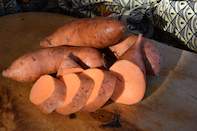
Pests
Sweet potato weevil
Adult weevils feed on foliage. The larvae tunnel into the storage roots and stems.
Control
- Crop rotation can help to reduce the weevil population.
- Ridging of the storage roots will generally reduce infestation.
- Burn all infested plants after harvesting.
- Use plant cuttings which are free from weevils or larvae.
- Do not plant cuttings close to the previous sweet potato crop.
- Remove all storage roots at harvesting and never use cuttings from volunteers (plants emerging in a field where sweet potato was planted the previous season).
- Reduce soil cracking.
- Adjust planting time so that storage roots are not present in the dry season.
- Timely harvesting, as ground storage in dry season promotes damage.
Sweet potato hawk moth larvae
Large green to brown larvae (caterpillars) with a tiny "horn" on the dorsal back of the body. They feed on leaves during the evenings.
Control
Hand picking of larvae is usually sufficient if numbers are not high.
Field Diseases
Fusarium wilt
Caused by Fusarium oxysporum, this disease can cause severe yield loss. When cutting through the stem of an infected plant, a reddish-brown discoloration of vascular tissues can be seen. The leaves turn yellow, blacken and die. Infected plants also infect the soil.
Control
- Plant tolerant varieties.
- Use disease-free planting material.
- Rotate crops with non-hosts.
- Limit as much as possible any stress such as water deficiency and high temperatures during the growth season.
Minor diseases
Alternaria Leaf Spot, Soft Rot, Sclerotium Wilt, Scurf and Foot Rot.
Control: as for Fusarium Wilt.
Storage Diseases
During storage, soft rot, surface rot and dry rot may occur.
Control
Do not harvest when soil is wet
Do not damage roots during harvesting. Wash off soil and cure roots.
Do not store damaged sweet potatoes and those showing signs of disease
Cure sweet potatoes before storing
Viral Diseases
Sweet potato feathery mottle virus (SPFMV) is the most common virus infecting sweet potatoes. It is found sometimes in mixed infection with other viruses. Although symptoms are seldom seen on the leaves, the yield decreases severely and cracked storage roots occur. When present, symptoms are commonly observed on older leaves showing some chlorotic spots and some mild vein clearing patterns. Severely infected plants are stunted and their leaves are smaller.
Transmission:
SPFMV is transmitted by aphids species which acquire the virus from an infected plant in less than one minute and then transmit it immediately to a healthy plant.
Control
- Plant virus-free planting material - obtain cuttings from registered vine growers or from ARC-VOPI.
- Control weeds in and around the field, especially wild lpomoea species.
- Use healthy looking, vigorous plant material.
- Remove volunteer sweet potato plants, debris and weeds from the previous season before planting.
- Renew planting material every 2-3 years.
- Clean all cutting equipment with a strong solution of Jik.